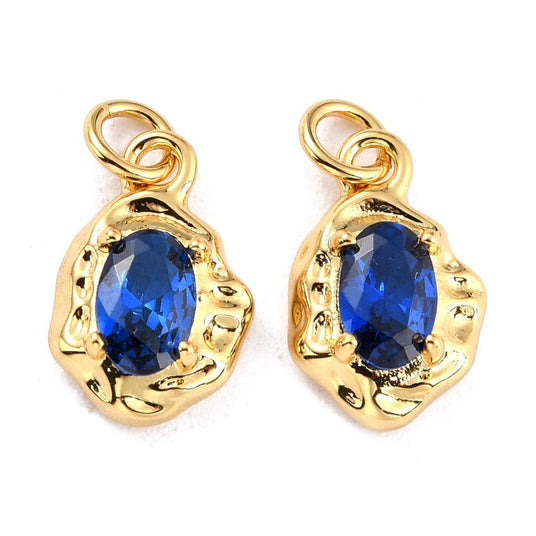Now that the nitty-gritty is out of the way, let's talk about which carat you should choose and what advantages one carat has over another.
24 karat gold
24 carat gold jewelry is not seen as often as some of the other types of carat. The same applies to gold coatings of 24 carat and this is because gold itself is an incredibly soft material which is easy to bend and scratch.
In addition, the color of gold in 24k tends to a more yellow-orange shade and is seen as being very light. It may be that you yourself have experienced a 24 carat piece of jewelery and thought that the gold color looked a little different from what you associate with the color gold.
Finally, 24k gold is also more expensive to buy. This is for the simple reason that if you have a 24 carat piece of jewelery versus a 12 carat piece of jewellery, it consists of twice as much gold. This therefore also means that the jewelery part has typically been twice as expensive to produce.
18 karat gold
18 carat jewelry parts and jewelry are probably the purest gold jewelry or jewelry part you can get, which is also resistant to everyday trials.
Below we list three factors that describe 18 carat gold.
1. 18 carat gold consists of 75% pure gold and 25% alloyed metal, for example brass.
2. 18 carat gold has the classic rich yellow gold appearance in color.
3. 18 carat is described as hypoallergenic and the right choice for you who suffer from sensitive skin and allergies.
All in all, 18 carat gold is a really good choice for you who are looking for the purest form of gold jewelery parts or jewellery, where you also want jewelery that is practical and can be worn on a daily basis.
If, on the other hand, you want a more resistant piece of jewelry, then maybe 14 carat is what you are looking for?
14 karat gold
14 carat is, together with 18 carat, the most used gold coatings when it comes to jewelery and jewelery parts. In fact, 80-90% of the world's wedding rings consist of either 14 or 18 carats.
A 14 carat piece of jewelery is easily recognisable. The piece of jewelry or piece of jewelry has the rich color of gold that most of us are familiar with. The gold color is a tooth less saturated and intense in color than an 18 carat gilding. Therefore, a 14 carat will also be the obvious choice for you who are looking for a piece of jewelery that is rich in colour.
Below we list five factors that describe 14 carat gold
1. 14 carat consists of 58.3% gold and 41.7% alloy metal.
2. 14 carat is significantly more resistant to scratches and scuffs than 24 carat.
3. 14 carat is considerably cheaper to purchase.
4. Called the "all-rounder" because of the good durability and quality of the gilding.
14 carat gold is probably the most widely used gilding carat available and this is not a coincidence. In a 14 carat gilding, you get the most for your money if you take durability, quality and price into the overall calculation.
In addition, the karate is still so pure in the gold that virtually all people will be able to wear this form of gilding, without experiencing skin irritations and allergies.
ATTENTION
Now that we are moving down the karat ladder, it is important to be told that the purity of the gold is decreasing. This means that people who have hypersensitive skin or suffer from allergies will be able to experience, for example, skin irritation.
10 karat gold
10 carat gold is the lowest purity of gold that can be obtained in a gilding where the gold can still be labeled and marketed as gold. And what does that mean?
This means that many countries today do not accept products as real gold unless they have a carat of at least 10 carats. However, this does not make 10 carat gold plating unpopular. On the contrary. Today, many of the world's earrings are plated or made with 10 carats. The color of a 10 carat gilding is easily recognizable if you have a keen eye for gold. The color often appears as a soft and pale color of gold.
A durable alternative to 14 carat
If you believe that your jewelery pieces must be incredibly resistant to scratches and scuffs, then 10 carat jewelery and jewelery pieces are a good choice. The high amount of alloyed metals such as zinc, copper etc., means that the piece of jewelery itself is extremely resistant to scratches.
Below we list four factors that describe 10 carat gold
1. 10 carat consists of 41.7% gold and 58.3% alloyed metals.
2. 10 carat is extremely hard-wearing and resistant to scratches and scuffs
3. 10 carat gold color appears softer and paler in colour
4. 10 carat is the cheapest gilding to buy, of gildings that are burned like real gold
Thank you for your time and now remember that gold plating behaves differently depending on who you are. That is probably the most important information you can take away from this blog post. Some can carry a lower carat without the gilding becoming unsightly, while others need to go higher on the carat scale.


